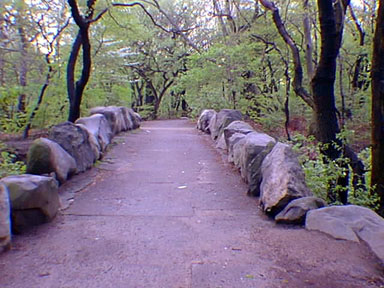62. Prospect Park
In many ways, Prospect Park is Brooklyn's best kept secret. The park
is another creation of Frederick Law Olmsted and Calvert Vaux. They considered
it a better work than their first collaboration, Central Park. The park
is another example of an artificial landscape design. The park design
took advantage of the natural topography of the Harbor Hill moraine (the
terminal moraine of the Stage 2 - Wisconsin glacier). However, most of
the original lay of the land has been altered to match the plans of the
park designers. The park was completed after the Civil War. Olmstead and
Vaux's plan was to reduce the amount of traffic and building within the
park (which was their primary criticism of their other park). In this
manner, the Brooklyn Botanical Gardens, the Brooklyn Museum, and the Grand
Army Plaza Library are located beyond the park boundary. With these options,
there is much to see and do for a day in the area (Figure 156).
 |
| Figure 156. Map of Prospect Park, Brooklyn, New York. |
To get there, take the IRT subway to Grand Army Plaza Station located
near the park entrance at Parkside and Ocean Avenues. Walking south, you
pass through The Vale and enter the Long Meadow. This long open space
is usually busy with people enjoying the park. Although the landscape
has been somewhat modified, its rolling topography gives the impression
of being a glacial landscape. On the west side of Long Meadow is a small
portion of the original hummocky topography of the Harbor Hill moraine.
A stone bridge over The Ravine is constructed from an abundance of glacial
erratics unearthed in the construction of the park (Figure 157). Many
large glacial erratics can be found scattered through the wooded landscape.
Most consist of gneiss from the Highlands region, but boulders of diabase
from the Palisades Sill can also be found.
 |
| Figure 157. A bridge built of local glacial erratics crosses The
Ravine in Prospect Park. |
|

